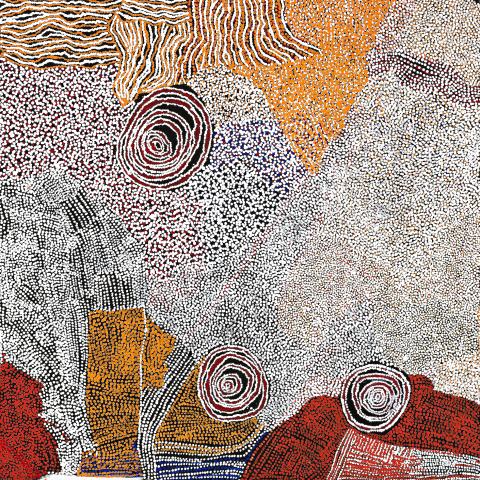ROCKHOLES AND COUNTRY NEAR THE OLGAS, 2008
BILL WHISKEY TJAPALTJARRI
synthetic polymer paint on linen
154.0 x 153.0 cm
bears inscription verso: artist’s name, title, size and Watiyawanu Artists of Amunturrungu cat. 10-08462
Watiyawanu Artists of Amunturrungu, Mount Liebig
Private collection, Melbourne
This work is accompanied by a certificate of authenticity from Watiyawanu Artists of Amunturrungu.
Glenis Wilkins, the Watiyawanu art coordinator, describes how whenever she opened the Aboriginal owned Mt Liebig art shed, Bill Whiskey would be there so keen was he to get his story down. Even if she was to open the art shed on a Sunday he would appear. "Secretly," he would even take small pieces canvas and linen back to his house where he would paint at night.
The current work belongs to the handful of works done just prior to his death in 2008, aged 87. These last works, though still based on his beloved country to the north-west of the Olgas, and featuring his "white cocky country" are distinguished by his masterful employment of a very powerful use of cadmium orange as well as (in this case), an equally pungent cadmium red; expensive pigments kept in a special place in the artists' shed. Carried away from the boldly blocked edges of the painting into its "interior" in the form of exquisitely refined dotted passages that in some areas are micro-pointillistic in scale, this deliberately limited palette harmonically plays with the radiant white dots representing the scattered cockatoo feathers surrounding the scene of the cockatoo's savage attack by the ancestral crow who aimed to steal the kangaroo meat that the ancestral cockatoo was feeding to its chicks. Close by is another site representing the eagle who came to the aid of the besieged cockatoo. In the vicinity there are also rock pools formed during the epic battle. But it is important to note that those who had the privileged fortune to visit the sacred site with the artist in 2007 report that at no point did he talk of the glowing white quartz fragments as "stones." They were feathers. Close observation will reveal the tracery of walking tracks and ancestral pathways (journey lines) concealed within and at times beneath the dotting.
On an optical level the retinal mixing of colours on the densely-worked painting surface, evokes the oscillating refractions of white quartz crystals on brightly coloured desert sand. In this way the whole painting is made to resonate, not just visually, but with the significance of the artist's Ancestral Story.
In its condensation of narrative detail and authoritative technique this work exemplifies Bill Whiskey Tjapaltjarri's unique contribution as passionate artist, senior custodian and also a Ngangkari (traditional healer). The outstanding quality of work produced he produced in such a short space of time (2004-2008) inspires wonder.
